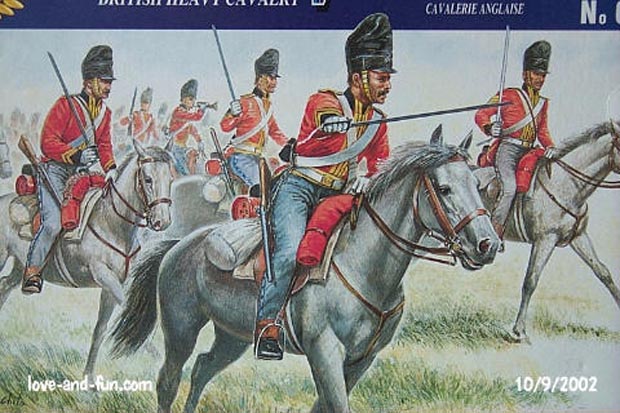British Napoleonic 2nd (Royal North British) Dragoons (Greys), 1812–1815
Italeri 1:72 Scale Figure Review

"Qu’ils sont terrible, ces Chevaux Gris" (L’Empereur Napoléon)
The Greys were raised in 1681 as the Royal Regiment of Scotch Dragoons and designated as the 2nd (Royal North British) Dragoons in 1751. Because of their grey horses, the regiment was also known as the Greys Dragoons, the name Royal Scots Greys was not officially adopted until 1877. British dragoons were actually heavy cavalry of the line, comparable to the cuirassiers of other European nations.
The miniatures are shown in the 1812 uniform with red coat, blue facings and yellow lace, black bearskin bonnets worn with a waterproof cover on campaign and grey trousers with blue sidestripe. This is the uniform worn during the 1815 campaign and at the Battle of Waterloo. The Greys served with Maj.-Gen. Sir W. Ponsonby’s 2nd British Brigade and they distinguished themselves with a famous charge, in the course of which Sergeant Charles Ewart captured the Eagle of the French 45e régiment de ligne.
Contents
18 riders in 9 Poses – 24 mm equal 173 cm Height
- Officer
- Trumpeter
- Dragoon with carbine, skirmishing (3)
- Dragoon with carbine, in reserve (3)
- Dragoon with drawn pistol (3)
- Dragoner with drawn sabre, attacking (3)
- Dragoon with drawn sabre, attacking (2)
- Dragoon with shouldered sabre (2)
- Dragoon with drawn sabre, in reserve (1)
18 horses in 6 poses – 21 mm equal 15 Hands
Evaluation
Superb Detail. Folds in the clothing, buttons, lace, belts and buckles, sabre hilts, horse furniture and stirrups are nicely detailed.
Riders are firmly seated on their horses and they have their legs pressing into the flanks of the mount.
Beautiful horses, correctly proportioned and with proper horse furniture, except for the pistol holsters which were not carried on campaign.
Useful historic poses. The figures may be deployed in attacking and skirmishing units. Sadly, there are no standing or walking horses available on which to mount the skirmishers. The trooper attempting to fire from the saddle is a nice figure which would have deserved a calmer horse for this purpose.
Riders are correctly equipped for the campaign, with grey trousers and waterproof covers over their bearskin bonnets. After 1812, British cavalry units rarely took their standards and guidons into the field, and the lack of a standardbearer figure is not a problem in this particular case.
Good casting quality, there is no flash on the riders, and the horses need very little clean-up work before they can be painted.
All of the horses are ambling at a full gallop, an obviously unnatural gait for a cavalry horse and very uncomfortable for the rider. The poses are overdone, heavy cavalry horses should be a little less theatrical looking, particularly if they are supposed to be charging across a battlefield.
There is no standing horse available to accomodate the skirmishing trooper. The poor man cannot possibly aim his carbine and hope to hit anything while being tossed around in the saddle of a galloping and ambling horse.
The front of the figure box shows the Greys with proper horse furniture, with a rolled cloak tied in front of the saddle and no pistol holsters. Sadly, the figures are not sculpted like that, they carry pistols holsters on either side of the saddle, although some holsters have been ommitted. Most of the holsters are empty, indicating that a pistol has been drawn, but only three of the riders actually hold a pistol in their hand! Apparently, the mistake has been carried over from the old ESCI figures which were equipped with the same holsters on their horses. One wonders why this obvious problem was not corrected when the figures were re-designed.
Incorrect painting instructions on the box. The Greys wore grey trousers with blue sidestripe on campaign. Carbine and pouch belts should be white, natural leather belts were only worn by the remaining dragoon regiments.
Historical Employment
- 2nd (Royal North British) Dragoons (Greys) 1812–1815
Possible Conversion
- When the heads are replaced with ones wearing the ESCI or Airfix French cuirassier helmets, these figures may be used to represent other British dragoon regiments:
- 1st (Royal) Dragoons 1812–1815
- 3rd (King’s own) Dragoons 1812–1815
- 4th (Queen’s own) Dragoons 1812–1815
- 6th (Inniskilling) Dragoons 1812–1815
Bibliography
- Haythornthwaite, Philip: Uniforms of Waterloo, plate 4
- Funcken, L. & F.: L’Uniforme et les Armes des Soldats du Premier Empire, p. 113
The famous 5th (Royal Irish) Dragoons nearly fell victim to a conspiracy after the regiment had served in the Irish uprising of 1798 and filled its depleted ranks with Irish recruits, some of whom plotted to kill the officers of the regiment. For security reasons, the regiment was disbanded in 1799, the regimental number remained vacant until 1858, when the 5th (Royal Irish) Lancers were raised.
Italeri’s Greys are reminiscent of the old ESCI Greys, but they are noticeably more detailed and cast in higher quality. The figure poses are much improved and so are the horses, even if they are sculpted in a very theatrical style now. Most importantly, Italeri’s horses have reigns whereas the ESCI horses had to have theirs added from thin paper or foil. Wargamers and collectors will find the Italeri figures quite versatile. Using the French cuirassier helmet, these figures are easily converted to cover the whole range of British dragoons. It would be fabulous if Italeri were to pick up ESCI’s popular French cuirassiers and lancers as well and upgrade them in a similar fashion.